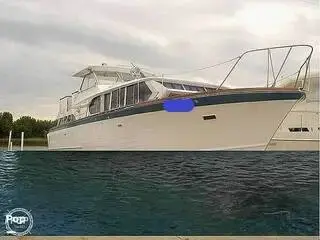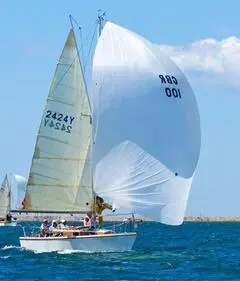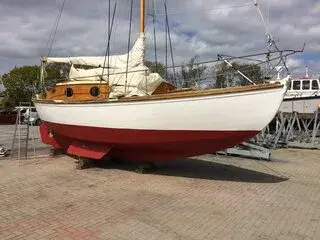
$16,000
LENGTH:
37.01 ft.
|
YEAR:
1967
LOCATION:
Bay City, Michigan
OFFERED BY:
POP Sells

LENGTH:
28.58 ft.
|
YEAR:
1974
LOCATION:
Hampshire
OFFERED BY:
The Metre Yard

LENGTH:
29.0 ft.
|
YEAR:
LOCATION:
Hants
OFFERED BY:
Wooden Ships Yacht Brokers

LENGTH:
29.99 ft.
|
YEAR:
LOCATION:
Hants
OFFERED BY:
Wooden Ships Yacht Brokers
Boat not available.
LOCATION
Saltash United Kingdom
YEAR
1970
LENGTH
31.99 ft.
Condition
Used
Name
Nicole
Year
1970
Make & Model
Nicholson Yachts 32 MK VIII
Boat type
Sail
Length
31.99 ft.
Fuel Type
Diesel
Location
Saltash United Kingdom
Beam
9.19 ft.
Draft Max
5.25 ft.
LWL
24.02 ft.
Nicholson 32 Mk VIIIBereavement sale, keenly priced at only: £12,000
The renowned Nicholson 32 class have always been a good looking yacht, and with her royal blue topsides, positive sheer and graceful overhangs, 'Nicole' definitely has that 'row away' factor [the pride of ownership as you row away from your boat, lying to her anchor or mooring]
She has seen good fundamental work done on her too, with a recent unused replacement (re-conditioned) engine; the topsides have been professionally painted in the not too distant past and the bottom epoxy-coated around the same time too.
All this, combining with the depth and 'full'- type of keel that exudes good, long-distance tracking ability and sea kindliness that is so often sought for those with over-the horizon ambitions.
While there will need to be a degree of recommissioning of systems and of course the newly fitted reconditioned Yanmar 3GM30, overall given the low price this yacht represents a better than average example of the Nicholson 32 Mk VIII model.
** E-Mail or Call us for a link to an extensive cloud based photo file**
The Mk VIII version of the Nicholson 32 marked the greatest change/improvement to the accommodation layout of the design until the later Mk X and so we shall commence our description with the main saloon, where the most significant changes were made.
Main Saloon: The Mk VIII layout features settee/berths just at seat height to either side of the Saloon, without a pilot berth outboard of and above the seating to the port side. A straight single berth, set further inboard than on earlier versions, could then be converted to a double berth by moving a drop-in fiddle rail toward the centreline with a plywood cushion support panel dropping into place behind that fiddle rail. On 'Nicole', at some point, the plywood panel appears to have been attached by hinges and now comes up against a hardwood block fitted to the main bulkhead that could easily be removed again to revert to the original arrangement and thereby be able to offer a double berth in the saloon again. A narrow, fiddled shelf to the port side has been fitted with a further 6" wide by 1" thick hardwood fiddle to be able to accommodate larger/heavier items on the shelf and to enable an entertainment radio/CD player to be mounted through it. The radio is no longer fitted, although two speakers remain mounted through the main bulkhead.
To starboard, the same single berth as in earlier versions remains unchanged, with the occupant's feet running into a 'trotter box' formed under the excellent 'stand-to' chart table that is such a feature of the Mk VIII. There are two closed, under-sidedeck lockers with a generous, fiddled book/almanac shelf between them. In common with all the other berths, there is front access to the locker space to be found under the berth/settee cushion for ease of access, without having to disturb the cushions above. A security safe by Chubb is fitted within the trotter box.
The main bulkhead's original, 'Hesian'-styled vinyl covering in grey and white has been painted over with a white, silk-finished vinyl coating in keeping with the rest of the accommodation spaces. Overhead plywood-backed vinyl panels appear to be the originals, with the vinyl detached in some minor areas, but overall still presentable, as are the stitched and suspended areas of vinyl that cover the internal surface of the coach-roof profile's 'step' - a notably valuable point. Two LED down-lighting lamps have been fitted to the overhead panels, one above the main table and the second over the galley.
A securely mounted double-leafed table is fitted on the cabin's centreline and would provide reasonably comfortable eating space for four diners.
Chart Table Area:The ruggedly-built chart table runs fore and aft, immediately outboard and to starboard of the companionway and features a large closed locker with fiddled shelf incorporated in the supporting structure. The lifting lid opens, accessing chart and instrument stowage within the table. To the aft end of the working surface a second lifting panel provides ready access to an insulated coolbox (with intermediate internal shelf) that is conveniently close to the rest of the galley.
A large and enclosed locker, immediately abaft the chart table unit and alongside the companionway is intended for use as an 'Oilies' locker.
Galley:A shallow 'U'-shaped galley is provided with the cooker between a relatively deep working surface - with a notably large single stainless steel sink - to the cook's left hand and another work surface to the right hand forming the trotter box over the port settee berth. A neat and unobtrusive cutlery drawer is carried beneath this latter work surface. A relatively recent 'Eno' stainless steel gas cooker has been set in the cooker aperture, incorporating two hob burners and an oven, but the gimballing and mounting arrangements, together with a protective crash bar have yet to be fully fitted.
The freshwater supply to the sink has been electrically pumped, appears to have been hand pumped more recently. Neither pump is currently in service; the handpump simply lying loose within the sink.
Heads Compartment:This compartment is located immediately forward of the main bulkhead, closed from the main saloon by a sliding door. The compartment is based on a white coloured GRP moulding, with white laminate-finished plywood locker doors within hardwood surrounds; all easy to wipe down and keep clean. The compartment runs across the breadth of the vessel at this point, with a moulded hand basin to starboard and a relatively recent Jabsco WC replacing what was probably an original Lavac toilet system to port. There is a generous half-height hanging locker outboard of the toilet and a shelved closed locker outboard of the hand basin. Freshwater supply to the latter has been electrically pumped, but the pump is not currently connected and there is a replacement stainless steel handbasin loose on board and to be fitted, should that be preferred.
Forward cabin:Accessed through a hinged door (lift-off hinges and carrying a hinged pedestal so that the door itself may be used as a cockpit table) and fitted with two single berths; one to each side of a centre-line chain pipe that carries the anchor's cable down to a chain locker located in the 'V' between the berths - nicely in from the end of the vessel. The berths are fitted with lee boards that serves to retain a berth occupant or loose gear in a berth when healed. There is convenient front access to the locker areas beneath the berths. The cabin/hull sides are finished by the original vinyl lined plywood panels (in good order), while any vinyl linings that had been adhered to the coachroof have been removed and the internal surface of the plain GRP moulding have been painted white. Light and ventilation are provided by a 'Canpa' deck hatch over and a single, 'Dorade' style, moulded ventilator above the starboard side's berth. Lighting is by two LED bulkhead-mounted reading lamps.
A previous Watermota Sea Panther engine has just been replaced with a re-conditioned Yanmar 3GM30 in the current ownership. The job has involved the replacement of the propeller shaft and the propeller itself, so those two items are new. The propeller is of fixed three-bladed design for satisfactory thrust.
A spacer is fitted in the shaft coupling to enable a 'Razor' type rope cutter and a ring anode to have been fitted ahead of the propeller. A conventional packing gland is fitted to the inboard end of the sterntube, with a remote greaser operable from within the port cockpit locker.
Electrical Systems
The electrical systems have been updated and improved upon in the current ownership, being based upon two battery banks (Domestic/Services and Engine Cranking). Two 115 A/hr lead acid batteries are securely fitted within the forward end of the cockpit's port locker and a single 140 A/hr battery is fitted within the engine space behind the galley.
Charging is by means of the engine-driven alternator and a photo-voltaic [Solar] panel, with a 'Rutland' wind generator still fitted on the vessel's starboard quarter, although it should be noted that this latter unit's serviceability hasn't been verified.
Although looking somewhat aged, the 'Solar' panel appears to be generating sufficient trickle top-up charge to the batteries, with a digital charge monitor located above the galley displaying an available charge of 14.4V on a cloudy day.
The 12V DC distribution system has been updated in the current ownership, with a new (hinge-down) panel accommodating two 6-way circuit breaker with switch panels. A battery charge indicator has not been connected at time of writing.
A 220-240V AC M200 battery charger by CTeck is fitted to be able to maintain the batteries while the vessel is connected to a shore support - in a marina for example.
Freshwater - Independent GRP moulded tank, located within the keel with its capacity noted as being 181 litres on its top surface.
Fuel: -60 litres max capacity.
Rigged as a Bermudan Sloop on the original aluminium alloy spars by Sparlight, together with a fixed length spinnaker pole by the same manufacturer. The mast is stayed with both forward and aft lowers in addition to the single backstay and the for'stay.
A Facnor SD150 roller reefing system is fitted on the for'stay to handle the headsail reefing/furling.
The main boom (originally designed to facilitate roller reefing of the mainsail) has been modified with fittings to be able to 'slab' reef the mainsail to its port side. A boom strut by Barton is fitted to support the boom - without re-course to having to have a topping lift - when reefing the mainsail.
A 'lazy', tensionable inner for'stay is fitted to be able to set hanked heavy weather canvas inboard of the outer for'stay.
Sails:
Fitted in the cockpit
Fitted below
General note on safety equipment:Any safety equipment such as Liferafts,EPIRBS, fire extinguishers and flares etc. are usually personal to the currentowner(s) and if being left on-board as part of the sale of a used vessel mayrequire routine servicing, replacement, or changing to meet a new owners specificneeds.
Engine Count
1
Engine Horse Power
24.0
Propeller Type
3 Blade
HULL
Ballast
3084
Hull Material
Fiberglass
OTHER
Displacement(kgs)
5534 kilograms
Drive Transmission Description
Direct
Engine Type
Inboard
No of Heads
1
Keel Type
Full Keel
The Nicholson Yachts 32 MK VIII is 32 feet long that boasts a 9.2 feet beam and a draft of 1.6 meters. This 1970 diesel Nicholson Yachts 32 MK VIII powered by Yanmar 3GM30 with 24.0 horsepower. The Nicholson Yachts 32 MK VIII is made of fiberglass.